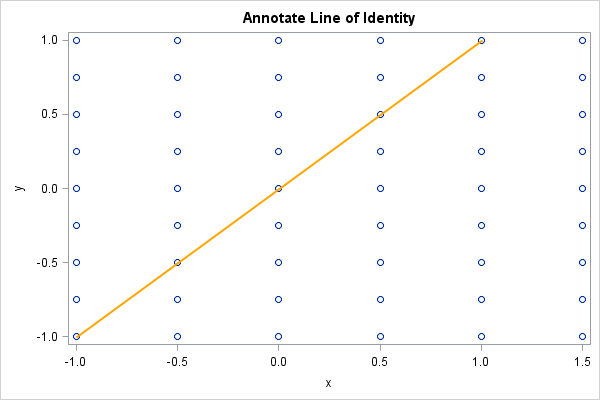Sample 49302: Annotate a line of identity on PROC SGPLOT output
 |  |  |  |  |
The sample code on the Full Code tab uses SG Annotation with the SGPLOT procedure to draw a line of identity on the graph.
These sample files and code examples are provided by SAS Institute Inc. "as is" without warranty of any kind, either express or implied, including but not limited to the implied warranties of merchantability and fitness for a particular purpose. Recipients acknowledge and agree that SAS Institute shall not be liable for any damages whatsoever arising out of their use of this material. In addition, SAS Institute will provide no support for the materials contained herein.
The sample code below uses SG Annotation to draw a line of identity (X=Y) on the graph.
data sample;
do y=-1.0 to 1 by .25;
do x=-1 to 1.5 by .5;
output;
end;
end;
run;
proc sql noprint;
select min(x), min(y), max(x), max(y) into :minx, :miny, :maxx, :maxy
from sample;
quit;
data sganno;
retain function 'line' drawspace 'datavalue' linecolor 'orange';
startline=max(&minx, &miny);
endline=min(&maxx, &maxy);
x1=startline; y1=startline;
x2=endline; y2=endline;
output;
run;
title 'Annotate Line of Identity';
proc sgplot data=sample sganno=sganno;
scatter x=x y=y;
run;
These sample files and code examples are provided by SAS Institute Inc. "as is" without warranty of any kind, either express or implied, including but not limited to the implied warranties of merchantability and fitness for a particular purpose. Recipients acknowledge and agree that SAS Institute shall not be liable for any damages whatsoever arising out of their use of this material. In addition, SAS Institute will provide no support for the materials contained herein.
This sample uses SG Annotation with the SGPLOT procedure to draw a line of identity on the graph.
| Type: | Sample |
| Topic: | SAS Reference ==> Procedures ==> SGPLOT |
| Date Modified: | 2013-03-21 09:43:19 |
| Date Created: | 2013-02-28 09:11:12 |
Operating System and Release Information
| Product Family | Product | Host | SAS Release | |
| Starting | Ending | |||
| SAS System | Base SAS | Aster Data nCluster on Linux x64 | 9.3 TS1M1 | |
| DB2 Universal Database on AIX | 9.3 TS1M1 | |||
| DB2 Universal Database on Linux x64 | 9.3 TS1M1 | |||
| Greenplum on Linux x64 | 9.3 TS1M1 | |||
| Netezza TwinFin 32bit blade | 9.3 TS1M1 | |||
| Netezza TwinFin 32-bit SMP Hosts | 9.3 TS1M1 | |||
| Netezza TwinFin 64-bit S-Blades | 9.3 TS1M1 | |||
| Netezza TwinFin 64-bit SMP Hosts | 9.3 TS1M1 | |||
| Teradata on Linux | 9.3 TS1M1 | |||
| z/OS | 9.3 TS1M1 | |||
| Z64 | 9.3 TS1M1 | |||
| Microsoft® Windows® for x64 | 9.3 TS1M1 | |||
| Microsoft Windows Server 2003 Datacenter Edition | 9.3 TS1M1 | |||
| Microsoft Windows Server 2003 Enterprise Edition | 9.3 TS1M1 | |||
| Microsoft Windows Server 2003 Standard Edition | 9.3 TS1M1 | |||
| Microsoft Windows Server 2003 for x64 | 9.3 TS1M1 | |||
| Microsoft Windows Server 2008 | 9.3 TS1M1 | |||
| Microsoft Windows Server 2008 for x64 | 9.3 TS1M1 | |||
| Microsoft Windows XP Professional | 9.3 TS1M1 | |||
| Windows 7 Enterprise 32 bit | 9.3 TS1M1 | |||
| Windows 7 Enterprise x64 | 9.3 TS1M1 | |||
| Windows 7 Home Premium 32 bit | 9.3 TS1M1 | |||
| Windows 7 Home Premium x64 | 9.3 TS1M1 | |||
| Windows 7 Professional 32 bit | 9.3 TS1M1 | |||
| Windows 7 Professional x64 | 9.3 TS1M1 | |||
| Windows 7 Ultimate 32 bit | 9.3 TS1M1 | |||
| Windows 7 Ultimate x64 | 9.3 TS1M1 | |||
| Windows Vista | 9.3 TS1M1 | |||
| Windows Vista for x64 | 9.3 TS1M1 | |||
| 64-bit Enabled AIX | 9.3 TS1M1 | |||
| 64-bit Enabled HP-UX | 9.3 TS1M1 | |||
| 64-bit Enabled Solaris | 9.3 TS1M1 | |||
| HP-UX IPF | 9.3 TS1M1 | |||
| Linux | 9.3 TS1M1 | |||
| Linux for x64 | 9.3 TS1M1 | |||
| Solaris for x64 | 9.3 TS1M1 | |||
